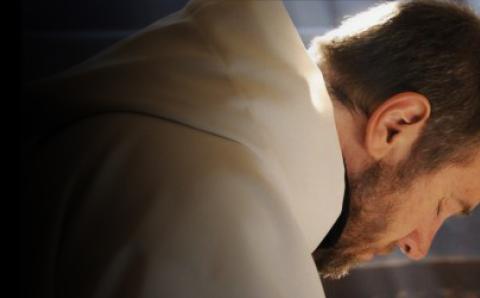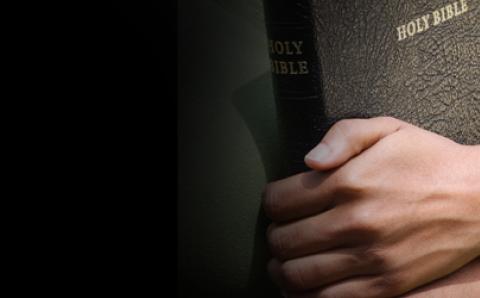How should we read the Bible? You might say that a more important question is Should we not read the Bible more? I will not quarrel with you. But in view of recent developments, we must face the question of the proper way to read Scripture.
The developments I refer to are the results of the Human Genome Project, which indicate strongly that the human race, as now constituted, did not descend from one human pair (Adam and Eve), as the early chapters of Genesis portray. Surely, many people will conclude that either Genesis is right or science is right. Articles quoting persons saying as much have appeared in several conservative and evangelical magazines.
I’d like to attempt, as briefly as possible, to offer a response that, I hope, deals responsibly with the matters in dispute that hit closer to home.
Calvin in the Fray
Calvin College has been drawn into the fray. Two Calvin professors wrote articles in the journal Perspectives on Science and Christian Faith. While the professors’ research was done under the auspices of the college, there was not a unanimous acceptance of their conclusions. Information concerning the college’s reaction has received media attention, including from National Public Radio, The Wall Street Journal, and The Grand Rapids (Mich.) Press.
Are we interested more in the what and the how than the who and the why?
From Sunday school classrooms to theological seminars, Christians often face questions regarding the Genesis story: Where is Eden? Where are the rivers? Where did Cain get his wife? Who are the people seeking to kill Cain? The answers to those questions rarely satisfy the teachers or the students. On the one hand some doggedly insist that Genesis is plain, literal history, while others declare it a myth and, therefore, not historical.
Is there another option? Some observations indicating how our culture affects the way we read the Bible may be helpful:
- Our culture is obsessed with information, while the Bible writers were more interested in personal relationships.
- We assume that information is best transmitted in simple and exact language, while the Bible writers were skilled in figurative language.
- We assume that plain, literal human language is adequate to describe history and human experience, while the Bible writers seem often to prefer the metaphor and other figures of speech.
Further, if we analyze human interests and human communication, it becomes clear that some people are interested in the what and the how, while others are interested in the who and the why. Is it fair to say that our culture, so influenced by technology, is interested more in the what and the how than the who and the why? (Would that not explain why our culture has made such enormous strides in technology?) Is it fair to say that the Bible writers were more concerned with the who and the why than with the what and the how? If so, then perhaps we “moderns” need to shift gears intellectually and emotionally when we read our Bibles.
The Trouble with Inerrancy
Our tendency to read the Bible in a literal way is borne out in the insistence by some that the Bible is inerrant.
Now, I trust that none of us would maintain that the Bible has errors—especially so when we see the list of noble evangelicals (among them such venerable names as Carl F. H. Henry, James Boice, and J.I. Packer) who in 1978 produced The Chicago Statement on Biblical Inerrancy. We would wish only to join with them.
It is noteworthy, however, that in Article XIII of the statement, these evangelicals “affirm the propriety of using inerrancy as a theological term with reference to the complete truthfulness of Scripture.” The stricture that the word inerrant be limited to theological purposes is helpful and appropriate. In the statement’s next paragraph, the signers “deny that it is proper to evaluate Scripture according to the standards of truth and error that are alien to its usage or purpose. [They] further deny that inerrancy is negated by biblical phenomena such as a lack of modern mechanical precision, irregularities of grammar or spelling, observational descriptions of nature, the reporting of falsehoods, the use of hyperbole and round numbers, the topical arrangement of materials, variant selection of material in parallel, or the use of free citations.”
That view seems very close to what we in Reformed circles usually call “the organic view of inspiration.”
Having said that, I find it necessary to also point out that our common understanding of the word inerrant may be somewhat misleading when we speak of “scriptural inerrancy.” Have we benefited from the limitations the authors of The Chicago Statement placed on the word?
Synod 1959 of the Christian Reformed Church appointed me, among others, to the Committee on Infallibility. The committee discussed at some length the usefulness of the word inerrant to describe the Bible. We concluded that it is not the most felicitous term to express the unique character of the Scriptures. We agreed that infallible and trustworthy fit the nature of the Bible more appropriately.
What’s wrong with inerrant? Well, it tends to characterize the Bible as an encyclopedia of unassailable facts on which we can build a case in any field of learning. Inerrant also tends to lead to an interminable discussion on the apparent “discrepancies” in Scripture. Finally, the term emphasizes the accuracy or exactitude of the Bible, while the Scriptures themselves emphasize the power of the word—Isaiah 55:10, for example: “For as the rain and the snow come down from heaven, and do not return until they have watered the earth . . . so shall my word be that goes out from my mouth; it shall not return to me empty, but it shall accomplish that which I purpose, and succeed in the thing for which I sent it” (NRSV).
Camera vs. Artist’s Brush
During discussions within the Committee on Infallibility, one of the members, the late Louis Praamsma, informed us that theologian and politician Abraham Kuyper maintained that the historiography of the Bible was not that of a camera but more like that of an artist’s brush.
That was an eye-opener for me. It suggested there is more to reality than the camera can capture. The concerns of the Bible are deeper than a camera can see. To put it more simply: human language often fails us in our relationship with God. As I once heard someone say, “What is worth saying cannot be said.”
The function as well as the limitations of human language came forcefully to my attention while I was working on a sermon on the prophet Nathan’s famous visit with David.
Nathan tells a story—most Bible commentators take it to be a parable—about a rich man stealing a lamb from a poor man in order that the rich man may entertain his friends. David, whom the Bible portrays as a king who judged his people with equity, is furious. But Nathan has news for him: David is the rich man!
In a sense, parables (even though they may not have happened literally) are history in an even more profound way than we usually understand history. In Nathan’s story the “lamb” is used instructively, demonstrating how skilled and subtle the ancients could be with metaphor.
At first the “lamb” is Bathsheba, but once slaughtered it becomes something else: the corpse of a loyal, innocent man—Uriah. Consequently it is much, much more than a chunk of mutton and wool. Tragically more historical!
Are the advances in science a fearsome enemy to faith?
Abraham Kuyper’s distinction of the camera vs. the artist’s brush helped me to understand that Nathan’s story teaches us one more thing about the Bible’s historiography: it is pastoral, it is God reaching out to the sinner.
David was not so stupid as to say, “There never was a lamb.” Instead, he pours out his soul to God in inexpressible regret: “Against you, you only, have I sinned” (Psalm 51:4). Hardly inerrant words. What about David’s sins against Uriah and others? Nathan’s story and David’s words inform us, as we try to understand the Scriptures, that human language is often inadequate to express what we want to and must say.
Stories like Nathan’s, and parables in general, tell us that parables are more “historical” than we might recognize. As one student put it, “God’s historiography is three-dimensional, or in three tenses: It refers to an event (past tense) according to the reader’s/hearer’s need (present tense) for guidance to appropriate action (future tense).” Nathan’s story surely demonstrates that.
Another student’s high school teacher noted that Harriet Beecher Stowe’s “Topsy” was more historical than any living African American girl. If Harriet Beecher Stowe could create a literary figure who profoundly affected the course of history (remember the Civil War and the Emancipation Proclamation) more than any flesh and blood girl, can the Holy Spirit not do that and more? Do we have the right to tell the Spirit how to write the Bible?
Another student pointed out his pastor’s indication of a clear symmetry in the Bible: the first chapters deal with the distant past, and the final chapters deal with the distant future. The pastor felt that both should be recognized as literature of a distinct type (genre, the scholars call it)—that in both the first chapters and the final chapters it’s important to see that history is told in a different, probably more metaphorical, way.
Throughout the Bible we must recognize that metaphor is a better vehicle for conveying the “deep things of God.” In John 3, for example, Jesus puts Nicodemus through his hermeneutical paces. “You must be born again,” Jesus says. What crazy language is that?! We wonder at how Nicodemus fussed. But what a thrill to meet Nicodemus again at the cross. He acts in a most “born again” way. He caught on!
What About Perspicuity?
Some may demur and say, “But did not the Reformers emphasize the perspicuity [clarity] of the Scriptures?”
Yes, they did. But that was in opposition to the Papists who wished to deny people the blessing of reading God’s Word for themselves. It does not mean the Reformers considered interpretation unnecessary.
In reading John Calvin’s commentaries on Scripture, there is one formula we encounter again and again. It goes like this: “Church father X understands the passage to mean . . . but I prefer the meaning that. . . .” (Admittedly, when Calvin takes on the Papists, another more caustic, vituperative formula appears.)
And Scripture itself indicates the need for interpretation: when Philip asks the eunuch whether he understands what he reads, the eunuch replies, “How can I unless someone explains it to me?” (Acts 8).
Yes, the plain and simple reading of Scripture is a blessing to all, but that does not mean we have no challenges. The Christian Reformed Church at its inception insisted on an educated clergy. Acts 15 makes clear that when there are interpretation problems, we must deal with them communally under the guidance of the Holy Spirit. And that does not mean that professional theologians or the church are infallible.
The “Galileo affair” should also be instructive for us. I think there is a pretty firm consensus among Christian historians that the manner in which the church handled it was not a service to Christianity.
Did the sun move, or did the earth turn? The medieval theologians could settle that with one text, Psalm 96:10— “the earth is established, that it shall not be moved.” Had they done their homework the theologians would have known that the psalmist was not concerned about cosmology per se, but that he was expressing his faith that God would not allow the sea to devour the land (a fear common among the ancients). The Lord would make certain that there would be a place for humans to live.
Trust the Spirit
I wish I could offer a simple and convincing solution to our present challenge. Should we not see it as a means by which God calls us to pray for the guidance of the Holy Spirit so that we may communally ponder these issues in faith and humility? Are the advances in science a fearsome enemy to faith? Or may we view them as a God-sent prod for the “theological orchestra” to pause and take note of whether the strings need tuning?
If Kuyper’s distinction between the camera and the artist’s brush is valid, can we view scientists as providing a more photographic account of history, while the Bible gives us the Artist’s account of history?
That would not mean one is valid and the other is not. It would mean that the photographs help tell us more clearly what the Artist is saying.
I was taught that science is the process of human thought in which theories are proposed and then tested to determine their validity. The result is constant review and revision in science. Theology too is a science. Theologians receive data from natural revelation and special revelation. Can theologians ignore the efforts and conclusions of those who work in the natural sciences? Could they learn from those findings, however tentative they may be?
It would seem that the need of the hour is prayer, openness to the Spirit’s leading, and an expectation that in the end our Christian faith will be more vital than ever!
For Discussion
- Do you believe that our culture affects the way we read the Bible? In what ways?
- Is it possible to bridge the gap between viewing Adam and Eve as useless fictional characters or as historical people? What tools do we need for proper interpretation?
- Describe the difference between believing the Bible to be inerrant and infallible.
- Vos says that “Abraham Kuyper maintained that the historiography of the Bible was not that of a camera but more like that of an artist’s brush.” How do you understand this?
- What about this topic makes you anxious? What gives you hope?
- How can we open ourselves to the wisdom and guidance of the Spirit regarding biblical controversies?
About the Author
Rev. Clarence Vos is a retired minister in the Christian Reformed Church and a professor emeritus of religion and Old Testament at Calvin College, Grand Rapids, Mich.









